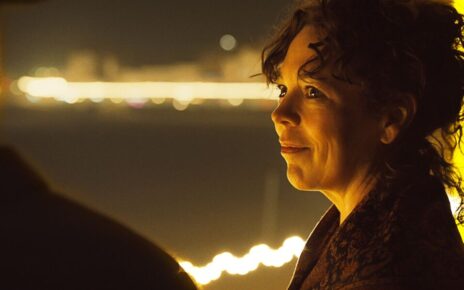A well-shot home movie is still a home movie. You get this, right? Out of context, the average home is equally as fascinating to me as the sidewalk or an empty field or an instruction manual to an appliance I don’t own.
Want to feel cheated? Check out the documentary of cinematographer Kirsten Johnson, consisting of film she shot that didn’t make it into other films. You heard me. This is a movie comprised entirely of outtakes. And it’s not like you can’t tell they’re outtakes; even the possibly endearing moments will make you say, “yeah, that wasn’t shot well. I can see why they took it out.” And since this film is a pastiche of the waste material from six or seven different projects, there’s also neither story, nor flow.
Kristen Johnson has filmed nothing all over the globe. She likes to advertise her travelogue to foreign lands like Uganda, Bosnia, and Wyoming. It strikes me as amazing how little excitement she seems to have captured of these exotic lands – the answer is, of course, that the exciting part of this footage is in another film. The first thirty minutes of Cameraperson is like watching television in Hell – or a really bad motel. “Bunch of goats … that sucks. Change it … A cityscape, nothing happening … that sucks. Change it … a lightning storm in the distance … Ok, I can work with that. Nope. Lingered too long. Change it … empty courtroom … that sucks. Change it … home footage of somebody’s apartment … that sucks. Change it … back to the goats. Bleah.”
Cameraperson is a potluck lunch consisting entirely of food that wasn’t eaten an hour earlier at the potluck lunch next door. Yeah, I suppose a tiny piece of pizza snuck through and the late arriving dessert wasn’t eaten in total, but Ms. Johnson has made a mishmash film entirely out of the stuff other films didn’t want and then passed it off as some sort of unique lunch vision. In a word: bunk.
It’s not that this film is entirely without merit, but there’s always something missing from whatever might capture your attention. The camera lingers on a -literally- newborn baby in a third-world nation. The baby struggles. Will it survive? All we have is the camera following the nurse. No voice-over. No direction. No background. The entirety of this world exists within a vacuum. I don’t know anything about this except what is precisely on screen and no more … and what’s on screen isn’t terribly descriptive. Later on we get to look at the chain used to drag a man to death in Jasper, Texas courtroom. That’s horrible. But all we get is the chain. No background. Who was the man? Why was he dragged to death? Go ahead, invent your own outrage. The most powerful inclusion among the recycles is a montage of places where human atrocity occurred: A warehouse in Bosnia, a slave-trade site in Western Africa, the road where a man was dragged. There’s power in the silence, but at the end of the day, you really haven’t shown us anything. It’s not unlike me randomly displaying a collage of atrocities like Auschwitz, Tiananmen Square and a Donald Trump rally in the middle of the Blair Witch review. What’s the point?
Look, what if I wrote an article consisting entirely of my outtakes: A sentence cut from Captain America, a phrase deleted from Star Trek Beyond, or just a mountain of misspellings and bad grammar? What would you think of that? This is Cameraperson in a nutshell – enjoy stuff that didn’t work in other films for irrelevance, poor quality or any number of other reasons.
misspellings and bad grammar? What would you think of that? This is Cameraperson in a nutshell – enjoy stuff that didn’t work in other films for irrelevance, poor quality or any number of other reasons.
I often call film cynical. Every time I see an unnecessary sequel to a successful film – e.g. Bridget Jones’s Baby, Now You See Me 2, Ice Age: Collision Course – you just know the primary reason this film exists is because of the paycheck envisioned. That’s film production at its most cynical—or what I previously believed was its apex of cynicism. This is worse. You never even had a vision or an idea to capitalize on; you simply took everything on your cutting room floor, packaged it into a new film, pretended that it had some semblance of structure or flow, and eventually charged me money for it. Want to know why people generally don’t choose independent film? This is it, fellas — it feels like you were too cheap to make a real film. Don’t sell me outtakes again.
♪I’ve got some pictures
Editors were above ‘em
This is my green light coup
Hollywood dream come true
Check what I shot with my camera
My mom is gonna love it, hey
I like my picture
Don’t care if it’s not better
Pretend it’s my print new
I’ll fool at least some of you
And you’ll cry about my camera
“Why did those people let her?”
Wait!
I’ll put in that shot, too
Wait!
Maybe one or a few
Then I think I’m done
You should see it for free
It’s my half-assed indie movie♫
Unrated, 102 Minutes
D: Kirsten Johnson
W: Kirsten Johnson
Genre: Patchwork quilt
Type of person most likely to enjoy this film: Cinematographers
Type of person least likely to enjoy this film: Storytellers
♪ Parody inspired by “Peg”




I remember the lynching in Jasper. James Byrd was a black man lynched by white supremacists. They dragged him for over 3 miles until his head and arm were severed. The Matthew Shepard Act’s full name is the Matthew Shepard and James Byrd Jr. Hate Crimes Prevention Act, which makes it all the more disappointing that Ms. Johnson included it without any context.
That’s truly horrible; shame on my ignorance. RIP, James Byrd. There’s a review of Matthew Shepard Is a Friend of Mine elsewhere on this blog — his name deserves attention as well, but I’ve already covered it.
Thank you for the background.